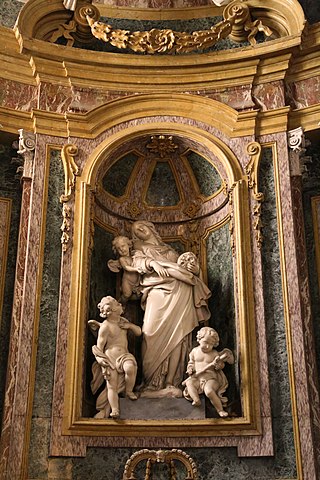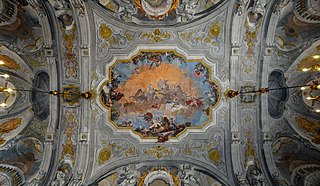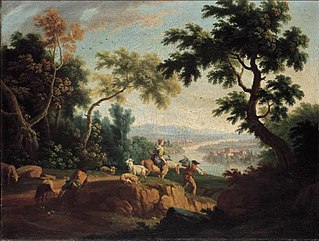Bibliography
- Luigi Mallè. Stupinigi. Tipografia torinese editrice, 1968.
Gaetano Perego (died 1783) was an Italian painter active in Northern Italy.
Few biographical details are known about this painter. He worked in the Sanctuary of Vicoforte in preparation for the wedding of Victor Amadeus III of Savoy and Maria Antonietta of Bourbon in 1750. In 1753–1780, he helped decorate the Carignano theater in Turin, and the Hunting Lodge of Stupinigi. He married the daughter of the painter Vittorio Amedeo Cignaroli. Perego died in Turin.

The Palazzina di caccia of Stupinigi is one of the Residences of the Royal House of Savoy in northern Italy, part of the UNESCO World Heritage Sites list. Built as a royal hunting lodge in the early 18th century, it is located in Stupinigi, a suburb of the town of Nichelino, 10 km (6 mi) southwest of Turin.

The Residences of the Royal House of Savoy are a group of buildings in Turin and the Metropolitan City of Turin, in Piedmont. It was added to the UNESCO World Heritage Sites list in 1997.

Nichelino is a comune (municipality) in the Metropolitan City of Turin in the Italian region of Piedmont, located about 8 kilometres southwest of Turin.

Vinovo is a comune (municipality) in the Metropolitan City of Turin in the Italian region Piedmont, located about 14 kilometres (9 mi) southwest of Turin.
Stupinigi is a frazione (hamlet/borough) of the comune (municipality) of Nichelino, in the Metropolitan City of Turin. It has a population of about 200. It borders the comuni of Candiolo and Orbassano on the southwestern outskirts of Turin, about 10 km from the centre of the city. Before 1869, it formed part of the comune of Vinovo.

The Basilica of Superga is a church in Superga, in the vicinity of Turin.

The Royal Palace of Turin is a historic palace of the House of Savoy in the city of Turin in Northern Italy. It was originally built in the 16th century and was later modernized by Christine Marie of France (1606–1663) in the 17th century, with designs by the Baroque architect Filippo Juvarra. The palace also includes the Palazzo Chiablese and the Chapel of the Holy Shroud, the latter of which was built to house the famous Shroud of Turin.

Giovanni Battista Bernero (1736–1796) was an Italian late-Baroque sculptor who worked, mainly in Piedmont, in a formalized restrained style, intermediate between baroque and Neoclassicism.

Giuseppe Nogari was an Italian painter of the Rococo. He painted mainly painted half-body portraits, either real or of historical and religious figures. They are striking for their emotional content, subdued decoration and coloration, and often display aged individuals in somewhat homely or shabby attire with a dark background.

Maria Anna of Savoy was a Princess of Savoy by birth and Duchess of Chablais by her marriage to her uncle, Prince Benedetto, Duke of Chablais.

North-Western Italian architecture refers to architecture in the North-Western regions of Italy, and their capital cities.

Benedetto Innocenzo Alfieri was an Italian architect, a representative of the late-Baroque or Rococo style.

Giuseppe Duprà (1703–1784) was an Italian painter born at Turin who was active in the eighteenth century.
Gaetano Perratone Armandi was an Italian painter, mainly of landscapes.

Michele Antonio Milocco was an Italian painter, of the late-Baroque period.

Giovanni Battista Crosato was an Italian painter of quadratura, active in the 18th century in Piedmont.

San Filippo Neri is a late-Baroque style, Roman Catholic church located in Turin, region of Piedmont, Italy. The church is located on Via Maria Vittoria 5; the left flank of the nave faces the Turin Academy of Sciences. The church is still used for services. 69 metres (226 ft) long and 37 metres (121 ft) wide, it is the largest church in the city of Turin.

Vittorio Amedeo Cignaroli (1730–1800) was an Italian painter and architect. He was the grandson of Martino Cignaroli.
Anna Caterina Gilli, was an Italian painter, active in Turin between 1729 and 1751. Her name is sometimes given as Gili or Gillia.
The Denominazione comunale d'origine (De.CO), or Denominazione comunale (De.Co.), is an Italian recognition established and granted by the municipal administration in order to protect and enhance a typical product, a traditional recipe, an agri-food business or a craft product in close correlation with the territory and its community, without any overlap with the designations of origin in force. The municipal designation of origin, unlike designations such as PDO, PGI and TSG, is not a quality indication, but a certificate of typicality.